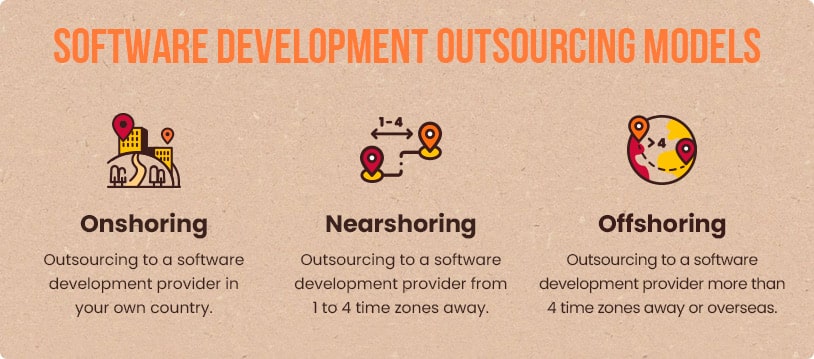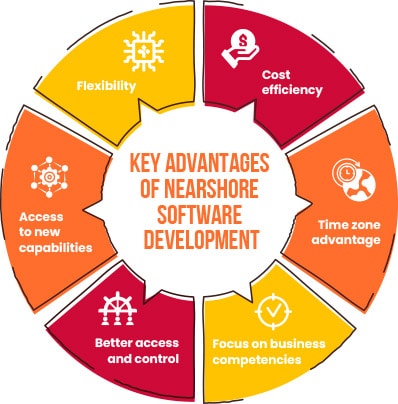
Software development companies constantly looking for options to cut their costs. It’s imperative such a cut wouldn’t affect their operational efficiency and the quality of their products or services. This is where nearshore software outsourcing shines best. This approach is recognized as an efficient and cost-effective business model which is why its popularity keeps increasing.
According to Statista, the IT outsourcing market's worldwide revenue is expected to grow at a CAGR of 10.99% from 2024 to 2028, reaching a market volume of US$777.70bn by 2028.
In this article, we will enlighten what is nearshore outsourcing of software development and what pros and cons it conveys to market players. We will also talk about other popular outsourcing models, and give tips on how to choose nearshore outsourcing company, and share expertise of A-Team Global in outsourcing.

What is nearshore software development outsourcing?
Nearshore software development outsourcing refers to contracting developers or QA engineers or other specialists from nearby countries instead of maintaining an in-house team. It also works as a staff augmentation approach. In geographical terms, this type of service is carried between a domestic tech vendor and its outsourcing provider within 1 to 4 time zones span.
For instance, nearshoring from Western Europe to Eastern Europe allows market leaders from France, Germany, or Scandinavia to nearshore software development in countries like Bulgaria or Ukraine. These countries are among the top five destinations for nearshoring within the EU. They are governed by the same laws (GDPR) as Western Europe countries and offer better tech service prices and quality.
By hiring non-domestic specialists, software companies get dozens of benefits that positively impact their operational activity. We will talk about these advantages in the next sections.
Nearshore development is best fit for projects that:
- Related to B2B, B2C, and SaaS verticals
- Require real-time coordination, but not necessarily face-to-face
- Use Agile methodology (still, can be adjusted to Waterfall, rapid app dev, DevOps, and other methodologies)
- Require real-time discovery and collaboration
- Are developing from scratch (however, works well for already existing projects)
- Related to the update of sophisticated legacy software systems
Now, let’s have a review of other popular types of outsourcing.
Alternatives to nearshore software development outsourcing

Speaking of nearshore outsourcing, we couldn’t omit the two other popular types of outsourcing: onshore and offshore.
Onshore software outsourcing
Onshore development involves the recruitment of software developers within the same country or region where your company is located. It typically represents the most costly option among the three outsourcing models, particularly for entities based in the United States.
The escalating demand for digital transformation has led to an unparalleled scarcity of skilled professionals, particularly within the US market. According to Gartner, there has been a surge in job vacancies, employee turnover rates, the duration required to fill vacant positions, and salary demands.
Onshore development is best fit for projects that:
- Require constant face-to-face collaboration
- Related to data privacy restrictions in terms of where developers are located
- Deal with physical elements of the solution that require the personal presence of software engineers
Offshore software outsourcing
Just like nearshore, offshore software outsourcing is about hiring tech specialists from other countries. The key difference is the distance between the software development companies. In this case, it’s more than 4 time zones.
Offshore development is best fit for projects that:
- Require repetitive tasks and non-automated processes
- Don’t require frequent real-time communication and Agile methodology
- Require a significant amount of development work, such as building complex software applications, platforms, or systems
Advantages and disadvantages of nearshore software outsourcing
Just like any business model, nearshoring has its pros and cons. In this section, we will review the most essential among them.

Time zones
For many projects, it is essential to have a team that can communicate in real-time so there is no question-answer time lag. With nearshore model, your and an outsourcing provider's teams have the same or almost the same business hours. So you can hold meetings and communicate on the go.
Frequently, the time zone gap poses a challenge for startups venturing into outsourcing for the first time. Nonetheless, at A-Team Global, our developers possess years of experience navigating various time zones. And our team elaborated on tactics to overcome such obstacles—such as adjusting work schedules and maintaining round-the-clock productivity in real time.
Cost efficiency
One of the key benefits of nearshore outsourcing is cost-effectiveness, offering access to top-tier talent at a reasonable rate. For instance, Central Europe is characterized by a lower cost of living compared to Western nations, while maintaining a high level of technical expertise among developers. This means you can obtain the same (or even better) quality of work without incurring higher expenses.
There are situations where tech vendors experience a lack of customers and keeping non-assigned in-house engineers drains companies' budgets. Companies can tackle the situation with nearshoring on-demand development teams. A 2022 survey revealed cost reduction (57%) as the leading reason for IT outsourcing, followed by accessing new capabilities (49%).

Access to an extended talent pool and new technologies
Outsourcing projects to another country provides access to the extended talent pool. This guarantees a steady inflow of skilled professionals, mitigating any workforce shortages. Sometimes, finding a developer skilled in specific technology can be a real chore. The nearshore labor market increases the chances of finding the right fit quickly.
Moreover, staff augmentation allows you to power up your in-house team without the need to conduct recruiting. As a result, you avoid repetitive hiring and termination processes, while paying solely for employees' productive hours.
Flexibility
Nearshore outsourcing offers greater flexibility in scaling development teams to match project demands. It empowers companies to promptly adapt to evolving market conditions or project specifications without the challenges associated with distant outsourcing arrangements. Thanks to this agility, you can maintain responsiveness and competitiveness in the fast-paced technology sector.
Better access and control
Offshoring development means the subcontracted team is situated at a considerable distance, with limited accessibility. Conversely, nearshoring implies geographical proximity, possibly just a short flight away, facilitating easier oversight. So you can arrange offline meetings in the provider's office when needed.
Focus on business competencies
Overseeing software development projects includes managing stakeholder requirements, budgets, and internal teams which is resourceful. Frequently, business owners and leaders may divert their attention from core competencies to address operational activities.
This is where nearshore outsourcing is invaluable. Collaborating with a decent nearshore outsourcing company enables the delegation of time-consuming operational tasks. At this point, you and your team can concentrate on business competencies and elaborate on your strategy.
Some traps of nearshore outsourcing
The trend of outsourcing business tasks to nearshore countries is steadily growing in popularity due to its inherent advantages. However, the model has specific pitfalls so let's check them out.
Fewer choices available
While nearshore outsourcing offers numerous advantages, its primary drawback lies in the limited array of options compared to other global regions. Opting for nearshore outsourcing narrows the selection of countries where you can find qualified contractors. Although offshore providers may offer specialized services and expertise for strategic business benefits, they might be less abundant than those accessible closer to your home.
Managing confidentiality
Managing confidential information poses a significant obstacle when collaborating with a nearshore software company. This can prove challenging if nearshoring firms fail to meet specific security standards or operate within certain legal frameworks. Some companies prefer to refrain from outsourcing tasks involving sensitive data, even if it means narrowing their talent pool options globally.
| At A-Team Global, the quality service safety and data security of our clients is our priority. Hence, we require all our developers to sign an NDA to ensure our clients’ sensitive details are secure. |
Possible communication challenges
Today, there is a plethora of communication tools available for connecting offices across different countries. Still, there remains a possibility of encountering challenges in cross-cultural and multilingual communication, even when the countries are close to each other.
How to outsource to a nearshore software team
To assist you in selecting the optimal nearshore outsourcing team for your requirements, we suggest following these three steps.
Evaluate your organization’s skills
Before outsourcing software development, it's imperative to understand your internal team's skill set. Conducting a staff survey is an effective method for assessing your team's expertise, offering a comprehensive overview of their strengths. Once you've drafted a project specification, create a shortlist of nearshore candidates possessing the specific skills you need. Reach out to each company with your project details and request a breakdown of their approach to the project. Based on their workflow processes aligning with your requirements, you can then select the most suitable company.
Validate the expertise of your shortlisted candidates
Before finalizing the decision to engage a software development company, conduct thorough due diligence. Request for a proven track record to ensure they possess the expertise you need. Start by reviewing their website and perusing their case studies. Additionally, consider reaching out to previous clients to validate the quality of their work. Further, verify their reputation in the marketplace by scrutinizing reviews on third-party websites and examining their social media presence.
Implement project management processes
Effective project management tools are integral for organizing and monitoring the progress of your nearshore project. Utilizing task managers and dashboards enhances communication with your development partners and ensures milestones are achieved. An organized workflow is paramount. With assigned project managers and team leaders you can track the progress and get regular updates.
What makes A-Team a reliable nearshore software development company?
A-Team Global provides comprehensive software development services for multiindustrial projects for more than 10 years. Having offices in Ukraine, Bulgaria, and Germany, we entirely cover the Europe region as a nearshore provider. Our expertise encompasses various technologies for your project development needs, including:
At A-Team Global, we offer software engineering and consulting services through two distinct business models:
- Staff augmentation: This approach is ideal for companies with an existing in-house tech team requiring additional expertise and workforce. Our clients typically opt for team extension when they need to undertake multiple projects simultaneously, experience a surge in traffic to an existing application necessitating rapid scaling, or encounter numerous routine tasks that their in-house team cannot manage on their own.
- Software development outsourcing: Another viable strategy, particularly favored by our European clients. This option is a good fit for companies that are not yet prepared to invest in building an in-house team but seeking a well-managed, controllable, and skilled tech unit to handle their projects remotely. This approach proves highly effective in the long term, with many clients initially hiring 1-3 programmers and subsequently expanding their team as their company grows.
We have a proven track record of successful projects for European clients. If you are looking for a reliable nearshore tech vendor for your projects, A-Team Global is a good match for you.
The bottom line
Nearshore software outsourcing is a strategic approach that involves contracting software development services to companies located in nearby or neighboring countries. This model offers numerous advantages for businesses seeking cost-effective and efficient solutions while maintaining proximity for easier communication and collaboration.
Despite there are several pitfalls, the nearshoring model keeps on expanding the IT market. The recipe for success here is finding a decent, tech-stack-charged, and reliable provider.
you may also want to read

Leveraging Local LLMs and Secure Environments to Protect Sensitive Information
In the rapidly evolving digital landscape, businesses are increasingly adopting Generative AI (GenAI) technologies to stay competitive and innovate. Large...

Boost Efficiency Today: Easy AI Integration for Immediate Results
In the past, the idea of integrating artificial intelligence into your business might have felt like venturing into uncharted territory—complex,...

A Roadmap to Gen AI Adoption for Small and Medium Businesses
Unlock new opportunities by integrating Generative AI into your business operations. In today’s fast-paced digital landscape, small and medium businesses...
